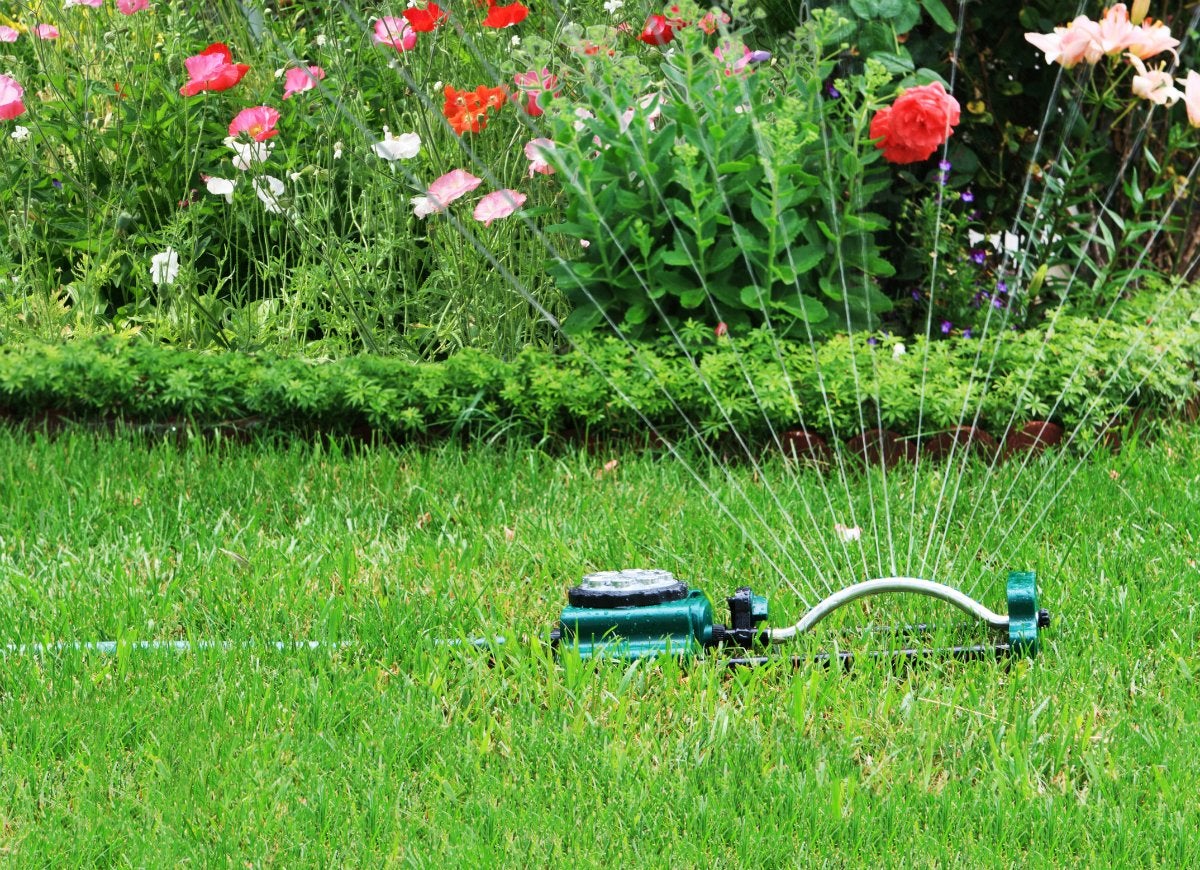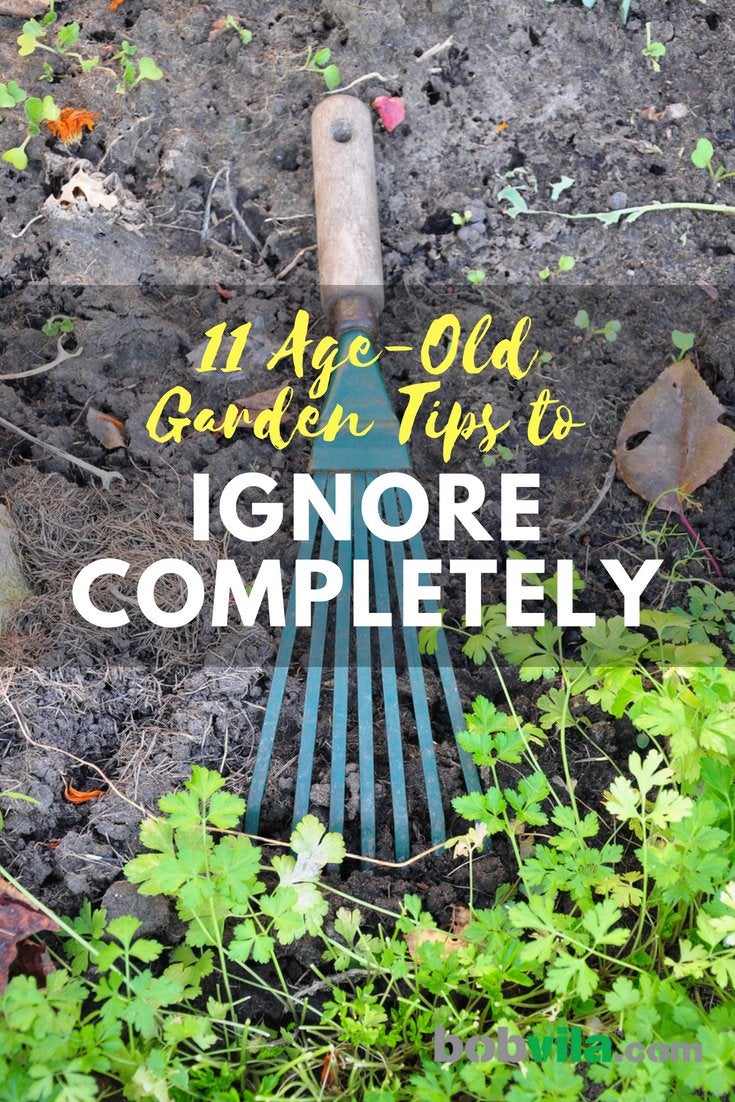We may earn revenue from the products available on this page and participate in affiliate programs. Learn More ›
Water Only in the Morning

Conventional wisdom holds that you should water your lawn and garden only in the morning, before the sun gets high in the sky. Supposedly, the water droplets left behind on plant leaves serve as tiny magnifying glasses for the sun’s rays that can lead to scorched leaves. In reality, water droplets that sit on nontropical plants are not strong enough magnifiers to cause the sun’s rays to burn a plant in that way. While water will certainly evaporate less before the sun is up, it’s still better to water thirsty plants midday than to wait until the next morning.
Stake All New Trees

You can save yourself the trouble of staking every new tree. The fact is, swaying in the breeze actually helps a tree to strengthen its newly established root system. You really need to stake new trees only when they are in a windy area or on a slope.
Related: The 15 Best Trees for Any Backyard
Dig a Big Hole for New Shrubs

The age-old recommendation for planting new shrubs is to dig a hole that’s twice as deep and wide as the root ball—but that’s not the whole story. You want the crown of the plant level with, or very slightly above, the surface of the soil once the root ball is covered. So, though the hole does need to be twice as wide, it just needs to be deep enough so the crown falls in that sweet spot. It is crucial, however, that the soil beneath the root ball be loose, not compact, so the roots of the plant can spread out and establish themselves more easily.
Related: 19 Ideas for Better Backyard Privacy
Use Organic Pesticides Because They're Safer

Just because the pesticide you’re using says “organic” on the label, that doesn’t mean it can’t potentially hurt you, your kids, or your pets. Natural pesticide ingredients, like pyrethrin (from chrysanthemums) or neem (from the seeds of the neem tree) are extremely toxic, just like their manmade counterparts. These alternative pesticides can even kill beneficial garden critters like frogs as well as ladybugs and other pollinators. So, use these pesticides if you need and want them, but don’t be lulled into a false sense of security.
Related: 20 Tips for Keeping All Critters Out of Your Yard and Garden
Loosen Clay Soil by Adding Sand

Dense clay soil is difficult for plant roots to penetrate and doesn’t provide adequate drainage. Many old gardeners will advise you to amend clay-rich soil by adding sand. Do that, and you will only create a harder, more concrete-like, soil. Instead, add compost to your clay soil to loosen it and improve drainage—and provide nutrition for your plants as well.
Use Pruning Tar to Help Heal Cuts on Trees

It isn’t really necessary to apply pruning tar to trees after you’ve trimmed the branches. Years ago, it was believed that covering those vulnerable wounds on a tree protected it from insects and diseases, but it’s just as well—and maybe better—to let trees go through their own healing process.
Thickly Mulch Around Trees to Help Retain Moisture

Laying wood-chip mulch around trees and garden beds is a great way to retain moisture and add more organic material to the soil. But too much of a good thing is often a bad thing—and mulch is a prime example. When adding mulch around a tree, avoid creating a “volcano” shape at the base. If the mulch is too close to the tree trunk, the bark will remain overly wet, inviting pests and disease. Instead, create a donut shape, with the mulch tapering down to nothing at the tree’s base. This practice will allow for airflow while suppressing weeds and retaining soil moisture.
Clean Gardening Tools with Bleach to Prevent Spreading Disease

Every experienced gardener knows that you need to clean your tools to keep from spreading diseases to your plants. But bleach is not the best solution for this. Prolonged contact with bleach can pit, discolor, or corrode the metal of gardening tools. Not only that, but if it’s not completely rinsed off, bleach residue on tools can damage the tissue of your plants and trees. Yes, you do need to clean and disinfect your tools, but use a household cleaner like Lysol for the job. It’s safer for your plants than bleach, and it’s noncorrosive.
Prune Back Transplants

It’s common advice to prune back shrubs and trees after you transplant them. The idea is that by reducing a plant’s foliage, you will encourage it to focus its energy on establishing roots in its new home. This practice actually does the opposite, however, spurring new growth in the pruned area and drawing energy away from the roots. Leave transplants alone, and prune only dead, broken, or diseased branches.
Related: 12 Expert Landscaping Ideas for the Front of the House
Promote Root Growth with Bonemeal

It seems like bonemeal has been a popular soil amendment forever. It is a natural source of calcium and phosphorus, which are needed for healthy soil balance. But calcium and phosphorus are not generally depleted in the home gardener’s soil, and neither mineral will actually stimulate root growth beyond what is normal for plants. Before spending money and time adding any amendment to your landscape, do a soil test to find out what your garden really needs.
Use Gravel to Improve Drainage in Containers

Many gardeners will tell you to put gravel in the bottom of your plant pots before adding soil to improve drainage and help ward off root rot. That advice, however, is all wrong. The layer of gravel allows water to pool and brings it closer to the plants’ roots. Instead, just use a coarse potting soil or one lightened with perlite, and make sure your plant pots have drainage holes that let excess water escape.
Mother Doesn't Know Best

Not every tip and trick passed down through generations is right. It’s best that you ignore these gardening hacks.

Want to Banish Weeds From Your Lawn Once and For All?
Join our FREE webinar event to learn how to keep weeds at bay this spring, and get a chance to ask lawn care and landscaping experts your weed control questions.
